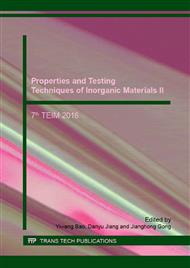[1]
V.K. Tolpygo, D.R. Clarke, Rumpling induced by thermal cycling of an overlay coating: the effect of coating thickness, Acta Mater., 5 (2004) 615-621.
DOI: 10.1016/j.actamat.2003.10.001
Google Scholar
[2]
Y. Liu, T. Nakamura, V. Srinivasan, et al, Non-linear elastic properties of plasma-sprayed zirconia coatings and associated relationships with processing conditions, Acta Mater., 55 (2007) 4667-4678.
DOI: 10.1016/j.actamat.2007.04.037
Google Scholar
[3]
Y. Adraider, Y.X. Pang, F. Nabhani, et al, Deposition of alumina coatings on stainless steel by a combined laser/sol–gel technique, Mater. Lett., 91 (2013) 88-91.
DOI: 10.1016/j.matlet.2012.09.082
Google Scholar
[4]
S. Ma, H. Huang, M.Y. Lu, et al, A simple resonant method that can simultaneously measure elastic modulus and density of thin films, Surf. Coat. Technol., 209 (2012) 208-238.
DOI: 10.1016/j.surfcoat.2012.08.072
Google Scholar
[5]
Y.W. Bao, Y.C. Zhou, X.X. Bu, et al, Evaluating elastic modulus and strength of hard coatings by relative method, Mater. Sci. Eng. A, 458 (2007) 268-274.
DOI: 10.1016/j.msea.2006.12.131
Google Scholar
[6]
B.K. Jang, H. Matsubara, Influence of porosity on hardness and Young's modulus of nanoporous EB-PVD TBCs by nanoindentation, Mater. Lett., 59 (2005) 3462-3466.
DOI: 10.1016/j.matlet.2005.06.014
Google Scholar
[7]
Z. Liu, Y.W. Bao, D.T. Wan, et al, A Novel Method to Evaluate Young's Modulus of Ceramics at High Temperature up to 2100 °C, Ceram. Int., 41 (2015) 12835-12840.
DOI: 10.1016/j.ceramint.2015.06.120
Google Scholar
[8]
Standard test method for Young's modulus, Tangent modulus, and Chord modulus, E111 – 04, ASTM, West Conshohocken, PA, USA, (2010).
DOI: 10.1520/e0111-04
Google Scholar
[9]
J. Tan, P.J. Meadows, D. Zhang, et al, Young's modulus measurements of SiC coatings on spherical particles by using nanoindentation, J. Nucl. Mater., 393 (2009) 22-29.
DOI: 10.1016/j.jnucmat.2009.05.001
Google Scholar
[10]
Y. Kajikawa, S. Noda, H. Komiyama, Preferred orientation of chemical vapor deposited polycrystalline silicon carbide films, Chem. Vapor Deposit, 8 (2002) 99-104.
DOI: 10.1002/1521-3862(20020503)8:3<99::aid-cvde99>3.0.co;2-c
Google Scholar


